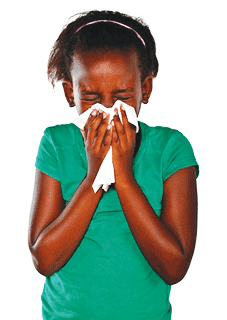Many people experience one form of allergic reaction or another. Experts say beyond first aid, once you’ve had an allergic reaction, it is important to identify the source, so you can avoid it in the future. Woman Editor, TEMITOPE DAVID-ADEGBOYE, writes.
 A few months after their new dog arrived in the house, Faith began to have itchy eyes and episodes of sneezing. Hope, the other child, also developed coughing and wheezing. Their parents, however, experienced no reaction whatsoever due to the presence of the new pet. A visit to the hospital and the doctor confirmed their fears: the children are allergic to the dog dander.
A few months after their new dog arrived in the house, Faith began to have itchy eyes and episodes of sneezing. Hope, the other child, also developed coughing and wheezing. Their parents, however, experienced no reaction whatsoever due to the presence of the new pet. A visit to the hospital and the doctor confirmed their fears: the children are allergic to the dog dander.
An allergy refers to an exaggerated reaction by the immune system in response to exposure to certain foreign substances. It is exaggerated because these foreign substances are usually seen by the body as harmless and no response occurs in non-allergic people. In allergic individuals, the body recognises the foreign substance and one arm of the immune system generates a response.
Experts say approximately 10 to 30 per cent of individuals in the industrialised world are affected by allergic conditions, and the prevalence has increased significantly over the last two decades and continues to rise.
Allergies can develop at any age, and the initial exposure or sensitisation period may even begin in the womb. Individuals can also outgrow allergies over time. Whereas many children outgrow food allergies, nasal or environmental allergies are something that individuals often grow into overtime, often into young adulthood.
Allergy-producing substances are called “allergens”.
Examples of allergens include pollens, dust mites, moulds, animal proteins, foods, and even medications. In adults, the most common foods that cause allergic reactions are shellfish, such as shrimp, crayfish, lobster, and crab; nuts from trees, such as walnuts, as well as fish, eggs and peanuts.
When an allergic individual comes in contact with an allergen, the immune system mounts a response through the IgE antibody. Therefore, people who are prone to allergies are said to be allergic or “atopic”.
IgE is an antibody that everybody has in small amounts. Allergic individuals, however, generally produce IgE in larger quantities. This antibody is important in protecting us from parasites. During a sensitisation period, dog dander IgE is over-produced and coats certain potentially explosive cells, such as mast cells and basophils that contain various mediators, such as histamine. These cells are capable of leading to an allergic reaction on subsequent exposures to allergen, which is the dog protein in this example. The dog protein is recognised by the IgE leading to activation of the cells, which leads to the release of various chemicals, including histamine. These chemicals, in turn, cause localised swelling, inflammation, itching and mucous production, all of which are typical allergic symptoms. Once primed, or sensitised, the immune system is capable of mounting this exaggerated response with subsequent exposures to the allergen.
According to experts, the parts of the body that are prone to allergic symptoms include the eyes, nose, lungs, skin and gastrointestinal tract.
Common allergic disorders
Allergic rhinitis (hay fever): This is the most common of the allergic conditions and refers to nasal and ocular symptoms that are due to aeroallergens. Year-round or perennial allergic rhinitis is usually caused by indoor allergens, such as dust mites, animal dander, or moulds. Seasonal allergic rhinitis is typically caused by tree, grass, or weed pollens. Many individuals have a combination of both seasonal and perennial allergies.
Allergic eyes (conjunctivitis) are inflammation of the tissue layers (membranes) that cover the surface of the eyeball and the undersurface of the eyelid.
Eczema (atopic dermatitis) is a condition commonly found in individuals with other allergic conditions (asthma and allergic rhinitis), but is not usually caused by direct allergen exposure. The rash results from a complicated inflammatory process.
Hives (urticaria) are skin reactions that appear as red, raised, itchy welts and can occur on any part of the body. Short-lived (acute) hives are often due to an allergic reaction to a food or medication, though they commonly result from a viral infection in children. Hives that recur over a longer period of time (chronic hives) are rarely due to an allergic reaction and the underlying cause is typically more complicated.
Symptoms
Cold symptoms such as sneezing, runny nose and congestion often appear one at a time. In allergy sufferers, these symptoms present at the same time and continue with exposure to the allergen. Sneezing is more common with allergies and the sufferer can sneeze multiple times in a row. Allergies tend to produce a clear, thin watery discharge. Colds can produce fever and yellowish thick discharge.
Experts, however, say minor allergic reactions can be safely treated at home. Over-the-counter (OTC) antihistamines and decongestants can ease congestion and breathing problems. These medications are generally available as tablets, eye drops, and nasal sprays.
Swelling, redness and itching may be reduced with the use of ice and topical creams that contain corticosteroids. Acetaminophen can lessen pain.
They also advice that beyond first aid, once you’ve had an allergic reaction, it’s important to identify the source, so you can avoid it in the future.
Caution
Check the ingredients of products around your house. Many contain fragrances or dyes that can irritate your skin.
Be sure to read food labels carefully. Packaged foods often contain surprising ingredients.
Stock your medicine cabinet with OTC topical treatment, antihistamines and pain relievers.
If symptoms persist, your doctor can prescribe more powerful medications.













